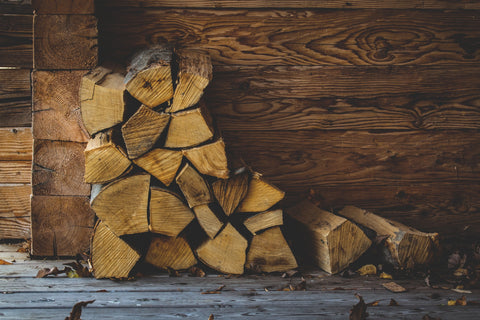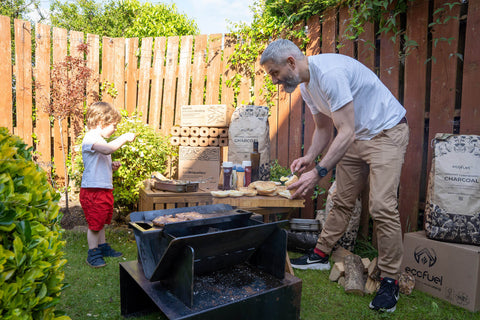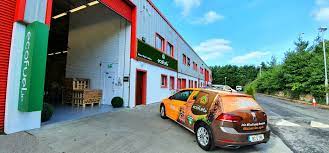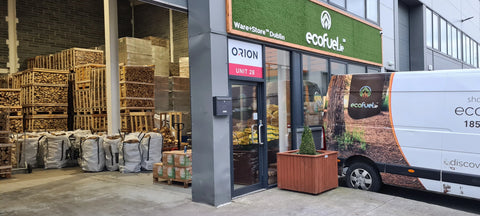
Choosing the right firewood to burn in your fireplace is crucial to constructing a beautiful fire, so this is why we have created a comprehensive and straightforward guide to what firewood you should use.
A couple of important things to think of when deciding what firewood to burn are the wood composition (hardwood or softwood), using dried or green (unseasoned and undried) wood and what type of fireplace you have.
Hardwood vs Softwood
Hardwood typically comes from deciduous trees (i.e. trees that lose their leaves every year), these trees usually take much longer to reach full maturity and therefore tend to be a much denser firewood meaning it burns for longer. In comparison, softwood is usually derived from coniferous trees such as Pine, Fir, or Spruce trees. These trees grow quite quickly and produce a less dense timber.
There is a lot of discussion around not using softwood in your fire because “it contains too much resin” or “it smokes too much”. We are of the opinion that once your firewood is sufficiently dried to a maximum 20% moisture content (more on this next!) the wood will burn well; softwood however does tend to burn much faster than hardwood. Due to their easy lighting and quick burn, softwood is an excellent option for kindling.

Hardwoods such as Oak or Ash are generally thought to be the better choice for firewood, and due to their dense composition they will burn at a more steady and consistent rate. Meaning you will get a longer burn for the quantity you put on the fire. With softwood varieties you could find you are using a lot more wood on your fire as it burns really quickly. Some softwoods can contain a lot of resin which when burnt will leave a residue called creosote in your chimney, this can cause blockages and lead to chimney fires.
Kiln Dried Firewood
The most important factor when choosing what firewood to burn is without a doubt, how well it’s dried. The generally accepted standard for dried wood is less than 20% moisture content, this goes for hard and softwood varieties.
‘Green’ or ‘Unseasoned’ wood simply will not burn as well as matured or dried firewood. Damp firewood will be slow to light, meaning you will really struggle to get a good fire going. Using green wood will also smoke a lot which can damage your chimney causing blockages, poor ventilation and increased production of carbon monoxide which (not to understate) is extremely bad for your health.

Commercially, kiln drying is the most popular method of drying wood for burning. This is due to the consistency that can be achieved in reducing moisture content and the time taken to dry the wood. Kiln Drying involves placing your wood in a specially designed thermal chamber that allows a regulated air flow to dry the logs to a precise moisture content quickly.
Alternative drying options include air drying (or seasoning) wood; this is the most popular method for collecting and drying your own firewood. Air drying can be done anywhere you have somewhat covered and open space which will allow a good airflow to dry out the timber. The difficulty with air drying however, is that timber takes quite a long time to dry naturally! Ideally you should be cutting and splitting your wood an absolute minimum of 6 months prior to when you are hoping to use it to ensure it is fully dried. While this method is one of the most traditional it can be impractical for most households to achieve.
The Most Popular Firewood Choices
The most common choices for firewood fuel are generally hardwood varieties. Ash, Oak, Birch, Olive and Beech are all notable mentions for various reasons which we will get into below.

Ash is perhaps the most popular choice of firewood as it is naturally low in moisture, gives off good heat and is excellent value. It will also burn reasonably well with minimal drying time and doesn’t spark much when burning. It can be burnt on its own or mixed with a slightly more dense wood for longer burning time.
Oak firewood produces a lot of heat and due to its dense nature when it is properly dried it will burn for a long time, making it excellent value. It will burn cleanly and with minimal smoke. Oak will burn exceptionally well in a closed stove with a controlled draft.
Birch looks great as decoration around your fire or while burning in it. The flame from burning birch will look gorgeous making it perfect for an open fireplace, you should be aware however, that it burns quickly. To remedy this it is advisable to burn it with a more long-burning log such as Oak. The bark of Birch is also excellent to use as a fire starter in place of kindling.
Olive like Oak is a very dense firewood meaning you get an extremely long burn from your logs. Burning equally well in open fireplaces or in closed stoves Olive is a very versatile firewood option that will give off a wonderful aroma when burnt.
Beech is a similar product to Ash and will burn especially well in a stove due to its good heat output. Beech firewood can be difficult to light a fire with so it is recommended to use kindling to get the fire started and add Beech later. The high water content in Beech wood means it can take a little longer to fully dry out for optimum burning.
Wood Briquettes & Heat Logs are an excellent alternative to logs and are extremely low in moisture content (apx 6-8%); due to their compressed nature they are very dense and burn as hot as coal. In EcoFuel, our wood briquettes and heat logs are made from the waste or byproduct of sustainable forestry and then compressed into their shape. They work extremely well used on their own or when mixed with other dense firewoods such as Oak.

Above we've given the BTU (British Thermal Units) ratings to give you an idea of the heat output for each wood type. This measurement is usually recorded as ‘million BTU per cord of firewood’. A cord of firewood is the equivalent to approximately 3.62m3 of firewood. So a BTU rating of 20 equals 20 million BTU per cord.
Will My Fireplace Affect My Choice?
Stoves not only produce radiant heat, they also produce convection heat warming the air in the room. For this they need a large amount of energy output, as hardwood fuels are a typically denser wood type they will produce this energy needed to give excellent heat and warm the whole room.

If you have an open fireplace in your home then hardwood fuels would again be more suitable for you to burn. This comes back to the density of the firewood, as we have mentioned softwood burns quicker than hardwood. If you combine this with the constant draft an open fire has, you will find you are constantly topping up your fuel. A hardwood in comparison will burn for longer in an open fireplace giving you better value in your fuel supply.
Our Recommendations
As different wood types will burn at different rates we recommend mixing your firewood for the best results in your fire. Every fireplace is different but this is our recipe for a long lasting and toasty fire.
Start with some kindling to get things going, when this has started to flame up top it up with a lighter wood such as Birch or Ash. When this is well lit top up with a dense wood like Oak which will take up the flame slower and burn for longer.
Updated Jun 2023




